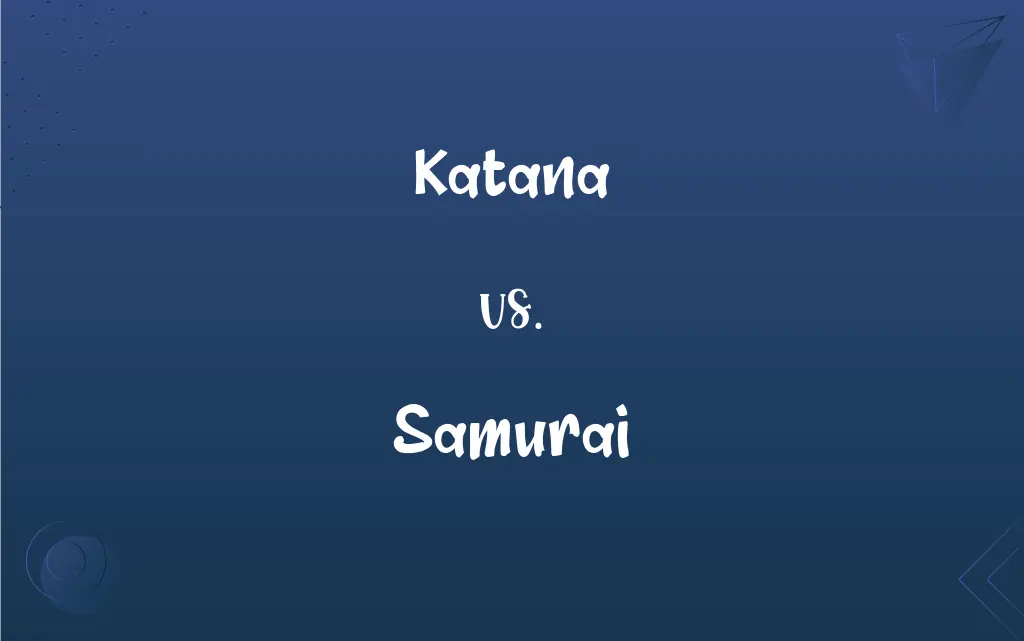Katana vs. Samurai: What's the Difference?
Edited by Aimie Carlson || By Janet White || Published on December 4, 2023
A katana is a traditional Japanese sword, while a samurai was a member of the Japanese warrior class.

Key Differences
The katana, a symbol of craftsmanship and martial artistry, is a traditional Japanese sword characterized by a curved, slender, single-edged blade. The samurai, on the other hand, were members of the feudal Japanese military nobility, embodying the warrior ethos. While the katana is an object, the samurai were individuals who often wielded the katana.
Originating from Japan, the katana is renowned for its sharpness and strength, often associated with the Samurai's identity. The samurai, as a social class, were not just warriors but also adherents of Bushido, the samurai code of honor. The katana served as a physical manifestation of the samurai's skill and honor.
The katana, with its unique forging process and distinct design, has become an emblem of Japanese culture. Conversely, the samurai, through their roles in history, politics, and society, significantly influenced Japanese culture and history. Both the katana and the samurai are deeply intertwined in their cultural significance.
In terms of craftsmanship, the katana represents a pinnacle of sword-making, requiring great skill and precision. Samurai were trained warriors who also needed to master strategy, martial arts, and often, cultural pursuits like poetry and calligraphy. Both required dedication and discipline.
The katana is often collected and admired for its aesthetic and historical value, while the samurai are remembered through literature, film, and art, symbolizing the virtues of loyalty, bravery, and honor. Both continue to fascinate and influence modern perceptions of Japanese heritage.
ADVERTISEMENT
Comparison Chart
Nature
A weapon; specifically a sword.
A social class; warrior nobility.
Origin
Physical object, made in Japan.
Historical role in Japanese society.
Symbolism
Represents craftsmanship and artistry.
Embodies the warrior ethos and Bushido.
Historical Influence
Celebrated for its design and making.
Influenced politics, culture, and society.
Modern Perception
Collected as a historical artifact.
Remembered through arts and popular culture.
ADVERTISEMENT
Katana and Samurai Definitions
Katana
A katana is a symbol of the samurai's honor and skill.
The katana was more than a weapon; it was a symbol of the samurai's way of life.
Samurai
A samurai was a member of the Japanese warrior class.
The samurai prepared for battle with focus and determination.
Katana
A katana is a long, curved Japanese sword traditionally used by samurai.
The warrior displayed his katana with pride.
Samurai
Samurai were skilled in various martial arts and swordsmanship.
The samurai trained daily to perfect his swordsmanship.
Katana
A katana is characterized by its distinctive appearance, having a single-edged blade.
The katana's blade gleamed in the sunlight.
Samurai
Samurai often served as military officers in feudal Japan.
The samurai commanded his troops with both wisdom and courage.
Katana
A katana is often regarded as a masterpiece of traditional Japanese craftsmanship.
The katana exhibited in the museum was a fine example of Japanese sword-making.
Samurai
Samurai were known for their strict adherence to the Bushido code.
The samurai lived his life according to the principles of Bushido.
Katana
A katana is used in various martial arts and ceremonial practices.
The martial artist skillfully wielded his katana during the demonstration.
Samurai
Samurai also engaged in cultural pursuits like poetry and calligraphy.
Aside from his martial skills, the samurai was also an accomplished poet.
Katana
A long, single-edge sword for use with two hands, traditionally worn by samurai.
Samurai
The Japanese feudal military aristocracy.
Katana
A type of Japanese longsword or tr=nihontō, having a single edge and slight curvature, historically used by samurai and ninja.
Samurai
A professional warrior belonging to this class.
Samurai
In feudal Japan, a soldier who served a daimyo.
Samurai
In the former feudal system of Japan, the class or a member of the class, of military retainers of the daimios, constituting the gentry or lesser nobility. They possessed power of life and death over the commoners, and wore two swords as their distinguishing mark. Their special rights and privileges were abolished with the fall of feudalism in 1871. They were referred to as "a cross between a knight and a gentleman".
Samurai
A Japanese warrior who was a member of the feudal military aristocracy
Samurai
Feudal Japanese military aristocracy
FAQs
Who were the samurai?
A warrior class in feudal Japan.
What is a katana?
A traditional Japanese sword with a curved blade.
Is katana a single or double-edged sword?
Single-edged.
What was the Bushido code?
The ethical code of conduct followed by samurai.
Are katanas still made today?
Yes, by skilled artisans following traditional methods.
What role did samurai play in Japanese society?
They were warriors, but also often scholars, poets, and administrators.
How was a katana made?
Through a complex forging process involving folding and tempering steel.
Did all samurai carry katanas?
Most did, as it was a symbol of their status.
What is the difference between a katana and a tachi?
A tachi is generally longer and more curved than a katana.
What is Iaido?
A martial art focusing on the drawing and cutting with a katana.
Could women be samurai?
Yes, there were female warriors known as Onna-bugeisha.
Did samurai follow any particular religion?
Many followed Buddhism or Shinto, but Bushido was more a moral code than a religion.
Did samurai write literature?
Yes, many were poets and chroniclers of their times.
What is the proper way to hold a katana?
With both hands, and the edge facing upwards.
Did samurai engage in duels?
Yes, duels were common for resolving personal or professional disputes.
What are the parts of a katana called?
Key parts include the blade (ha), handle (tsuka), and guard (tsuba).
Can katanas cut through steel?
While very sharp, they cannot cut through other steel objects.
Were samurai paid for their services?
Yes, often in rice or land grants.
How heavy is a typical katana?
Usually between 1.2 to 1.5 kg.
What was the main diet of a samurai?
Primarily rice, vegetables, and fish.
About Author
Written by
Janet WhiteJanet White has been an esteemed writer and blogger for Difference Wiki. Holding a Master's degree in Science and Medical Journalism from the prestigious Boston University, she has consistently demonstrated her expertise and passion for her field. When she's not immersed in her work, Janet relishes her time exercising, delving into a good book, and cherishing moments with friends and family.
Edited by
Aimie CarlsonAimie Carlson, holding a master's degree in English literature, is a fervent English language enthusiast. She lends her writing talents to Difference Wiki, a prominent website that specializes in comparisons, offering readers insightful analyses that both captivate and inform.
































































